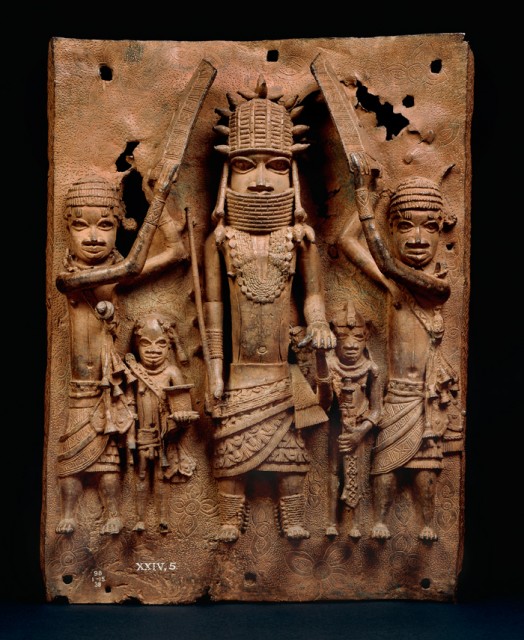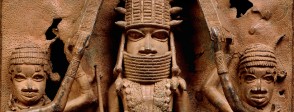
Acquisition
This is one of more than 900 plaques that show aspects of the Benin court in the fifteenth to sixteenth centuries following Europe’s first contact with West Africa. They were seized by the British when looting the royal palace of Benin in 1897 as punishment for the killing of a British delegation. The objects were in storage at the time as the palace was being refurbished. They were brought to Britain and sold to museums across the world.
What it shows
The kingdom of Benin was as powerful, complex and sophisticated a culture as any in Europe and the rest of the world at this time. To understand the image, we need to know about the trappings of royalty and the role of the Oba in Benin society. This plaque seems to show a procession, with the Oba flanked by attendants who shade him from the sun with their shields. In pre-colonial times the Oba was regarded as the highest political and religious authority and respected as the representative of the ancestors, so only he was allowed to be shaded in this way within the city.
The Oba is at the centre of the composition and the largest of the five figures. He is wearing a crown and a tunic of woven red coral beads. Coral was rare and valuable and obtained by trade from as far away as the Mediterranean Sea. His attendants are dressed in fine cloth worked in elaborate patterns, in colours we can only now imagine. Smaller figures, whose size as well as their scanty clothing shows their lesser importance, carry a ceremonial sword and a kind of circular box used to present gifts. The plaque was found near another that also depicts the Oba and four attendants and it is likely that they were a pair. The plaque has holes drilled in the corners so that it could be hung as symbolic decoration on wooden pillars on the façade of the palace.
The Oba and his court
The central position of the Oba on this plaque is representative of his position within the state. He was the head of the kingdom as both political and spiritual leader. He led the council of chiefs who made decisions on matters such as war, trade, taxation and ceremonial events, and while the chiefs might be powerful and influential, the Oba held the overriding authority. The Oba derived his power not just from the social and political world of Benin, but also from the spiritual world through his link to the great god Olokun, ruler of the sea. In its turn, the palace was the spatial centre of the city state, providing the administrative frameworks for administering the affairs and wealth of its empire and the physical structure on which the symbols of the state and its leader could be displayed.
Not surprisingly, the plaques give a one-sided view of the kingdom of Benin in that they only show images of the Oba in which his prestige and power are glorified. All the people depicted on the plaques are men and while there are differences of function, status and age, they are all shown in the service of the king. Although they do not appear on the plaques, women were shown in other sculptures in the palace and the great importance of the role of Queen Mother was demonstrated by the casting of heads of Queen Mothers which were placed on altars around the palace.
More information
A History of the World in 100 Objects
The BBC’s A History of the World in 100 Objects focusing on the plaque in For the classroom. Listen to the programme or read the transcript.
http://www.bbc.co.uk/ahistoryoftheworld/objects/rmAT6B7zTZCGACd7i7l6Wg
From the Metropolitan Museum of Art
Images and articles from the Metropolitan Museum of Art covering aspects of Benin, including thematic essays on techniques of casting and on Idia, the first Queen Mother of Benin.
http://www.metmuseum.org/toah/hd/beni_1/hd_beni_1.htm
Benin plaques in the British Museum
Collection online results for all plaques in the British Museum.
http://www.britishmuseum.org/research/collection_online/search.aspx?searchText=benin+bronzes+
Lost Kingdoms of Africa
Art historian Gus Casely-Hayford in the BBC’s Lost Kingdoms of Africa. The sequence on Benin ends at 17:30.
https://www.youtube.com/watch?v=QW_kaUuUg8Y
Tribal Eye (1975)
David Attenborough in the 1975 BBC series Tribal Eye. The sequence to 11:30 covers the British punitive expedition and gives a particular interpretation of the events.
https://www.youtube.com/watch?v=g2sU3zTVkI4
Resources on teaching about Benin
A scheme of work, background information and activities for teaching Benin.
http://www.britishmuseum.org/learning/schools_and_teachers/resources/all_resources-1/resource_art_of_benin.aspx
Teaching African civilisations
A set of resources and teaching materials for African civilisations including Benin.
http://www.britishmuseum.org/learning/schools_and_teachers/resources/all_resources-1/wealth_of_africa/african_civilisations.aspx
Fact-sheet from the Pitt Rivers Museum
A brief overview of Benin with downloadable fact-sheet from the Pitt Rivers Museum, Oxford.
http://www.prm.ox.ac.uk/benin.html
The Art of Benin
Book by Paula Girshik Ben-Amos, Smithsonian Books 1995.
http://books.google.co.uk/books?id=sAXqAAAAMAAJ&source=gbs_book_similarbooks
The Art of Benin from the British Museum
Book by Nigel Barley, British Museum Press, 2010.
http://books.google.co.uk/books/about/The_Art_of_Benin.html?id=Vm9JAQAAIAAJ&redir_esc=y
More information
-
A History of the World in 100 Objects
The BBC’s A History of the World in 100 Objects focusing on the plaque in For the classroom. Listen to the programme or read the transcript.
Source: bbc.co.uk
-
From the Metropolitan Museum of Art
Images and articles from the Metropolitan Museum of Art covering aspects of Benin, including thematic essays on techniques of casting and on Idia, the first Queen Mother of Benin.
Source: metmuseum.org
-
Benin plaques in the British Museum
Collection online results for all plaques in the British Museum.
Source: britishmuseum.org
-
Lost Kingdoms of Africa
Art historian Gus Casely-Hayford in the BBC’s Lost Kingdoms of Africa. The sequence on Benin ends at 17:30.
Source: youtube.com
-
Tribal Eye (1975)
David Attenborough in the 1975 BBC series Tribal Eye. The sequence to 11:30 covers the British punitive expedition and gives a particular interpretation of the events.
Source: youtube.com
-
Resources on teaching about Benin
A scheme of work, background information and activities for teaching Benin.
Source: britishmuseum.org
-
Teaching African civilisations
A set of resources and teaching materials for African civilisations including Benin.
Source: britishmuseum.org
-
Fact-sheet from the Pitt Rivers Museum
A brief overview of Benin with downloadable fact-sheet from the Pitt Rivers Museum, Oxford.
Source: prm.ox.ac.uk
-
The Art of Benin
Book by Paula Girshik Ben-Amos, Smithsonian Books 1995.
Source: books.google.co.uk
-
The Art of Benin from the British Museum
Book by Nigel Barley, British Museum Press, 2010.
Source: books.google.co.uk


